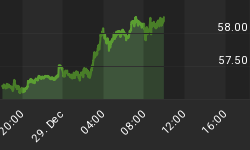October is in the books, and an extremely volatile one at that. There were upside and downside surprises across the board as individual stocks reacted in various ways to earnings and production results and merger announcements. For the month, the XAU traded erratically sideways with a slight downward bias, starting at around 110 and ending at just under 108. This was technically in keeping with the October seasonal outlook for the XAU, although we had hoped for a better performance based on the head of steam the index had developed earlier this summer.
Now that we've entered a new month, what can we expect for the XAU's performance in November based on past history? What follows is an overview of the XAU's seasonal tendencies for the month.
November 1994 was a solidly down month for the XAU, but this was attributable to the 10-year cycle bottom of that year. The XAU fell victim to across-the-board broad market selling pressure in November '94 and fell from approximately 115 at the beginning of the month down to around 102 at month's end.
November of '95 was a positive month for the index as the XAU started at around 107.50 and rallied up to above 120 by the end of the month that year. The XAU had fallen sharply in October and its technical indicators had reached deep "oversold" readings by the start of November, which aided the rally.
November 1996 saw a mild rally in the XAU index. It started the month at around 115 and ended at 120, making an intra-month high at just under the 130 level.
November 1997 was a bearish month for the XAU, as the XAU had been in a falling trend since early October. In November of '97 the XAU fell from 90 down to 70 at month's end.
In November 1998, the XAU was down slightly. It began the month at about 74, then rallied up to 85 early in the month before succumbing to resistance pressure and ending up at just above 70 at the end of the month.
In the following November of '99, the XAU was net sideways for the month. It traded in a narrow band between 65-72.
November 2000 saw the XAU rally a bit, coming off its low for the year at the 42.50 area and rallying to almost 48 by the end of the month.
November 2001 was another downer for the index, as the XAU started the month at 56 and fell to the 50 area where it closed out the month.
November 2002 also saw the XAU decline, falling from its high of about 70 to a low of around 64.
November 2003 was a bullish month which saw the XAU rally from its start at 95 early in the month up to 110 at the end of the month in what was a final flourish in a bullish year.
November 2004 was also a bullish month for the XAU, during which the index rallied from 100 up to 110 at the end of the month.
The tally for the XAU's November trading record for the past 11 years is five up, five down and one neutral. That's practically an even split as to whether the month of November will be up or down for XAU.
What observations can be gleaned from the above historical overview? For one, the XAU is likely to have a bearish November if it enters the month below its 60-day moving average. When, however, it enters the month above the rising 60-day trend line the month of November is more likely to be a positive one. This was the case in the following Novembers: 1995, 2003, and 2004. The one exception to this in the past decade was in 1998.

It also helps when the XAU enters the month of November in a technically "oversold" position, as is presently the case for the XAU.
















